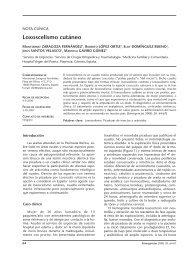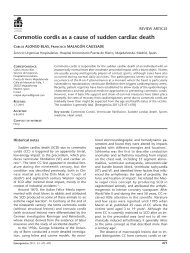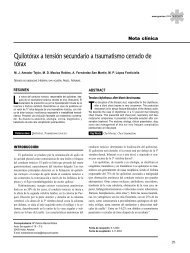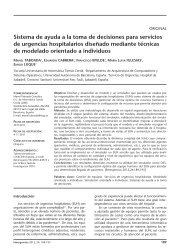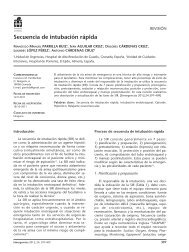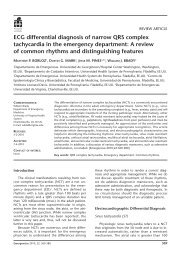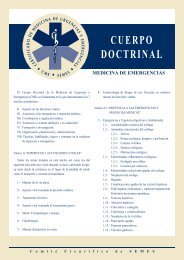Traumatic Intercostal Pulmonary Hernia - Semes
Traumatic Intercostal Pulmonary Hernia - Semes
Traumatic Intercostal Pulmonary Hernia - Semes
You also want an ePaper? Increase the reach of your titles
YUMPU automatically turns print PDFs into web optimized ePapers that Google loves.
LETTERS TO THE EDITOR<br />
Protruding atrial thrombus in the left<br />
ventricle<br />
Sir,<br />
As recently published in EMERGENCIES 1 , ultrasound<br />
(US) as a diagnostic procedure can be<br />
most useful and we here suggest a number of potential<br />
indications for use in the emergency department<br />
conducted ED physicians 2 . We present a<br />
case with rare US findings which significantly conditioned<br />
our therapeutic approach and probably<br />
averted dire consequences.<br />
Figure 1. Admission chest X-ray (above) showing right lung<br />
atelectasia, and (below) X-ray after bronchoscopy showing<br />
subsequent evolution.<br />
plete atelectasis of the right lung, partially resolved with<br />
bronchoscopy (Figure 1), during which more bread and<br />
copious secretions were removed.<br />
The migration of aspirated foreign bodies into<br />
the tracheobronchial tree, most often to the right<br />
side, may cause obstructive atelectasis that requires<br />
bronchoscopy for resolution 2 . Occasionally, longstanding<br />
aspiration of a foreign body with irreversible<br />
changes in the lung wall may require surgery 3 .<br />
References<br />
1 Handley AJ, Koster R, Monsieurs L, Perkins GD, Davies S, Bossaert L,<br />
et al. European Resuscitation Council Guidelines for Resuscitation<br />
2005. Section 2. Adult basic life support and use of automated external<br />
defibrillators. Resuscitation. 2005;67(Supl. 1):S7-S23.<br />
2 Sauret Valet J. Cuerpos extraños. Arch Bronconeumol. 2002;38:285-7.<br />
3 Montero Cantú CA, Garduño Chávez B, Elizondo Ríos A. Broncoscopia<br />
rígida y cuerpo extraño. ¿Procedimiento obsoleto? Cir Ciruj.<br />
2006;74:51-3.<br />
Rosa María GARCÍA FANJUL,<br />
Eva GARCÍA PINEY<br />
Servicio de Medicina Intensiva. Hospital de Cabueñes,<br />
Gijón. Asturias, Spain.<br />
The patient was a 66 year-old woman without<br />
known cardiovascular risk factors, a history of atrial<br />
fibrillation (AF), treated with aspirin 100 mg/24 h<br />
and atenolol 25 mg/24 h. She was referred to our<br />
ED for fatigue and dyspnea with moderate exertion,<br />
with no other clinical symptoms. Physical examination<br />
and baseline laboratory results were normal, and<br />
with AF under control. Echocardiogram showed apparently<br />
normal contractility without valve lesions,<br />
but also dilated left atrium containing a mobile mass<br />
of 2 cm near the mitral annulus. The study was therefore<br />
completed with transesophageal echocardiography<br />
(Figure 1A) by the cardiology department, reporting<br />
a mobile thrombus occupying the left atrial<br />
appendage which protruded into the left atrium,<br />
crossing the mitral ring and visible in the left ventricle<br />
during diastole (Figure 1B). The patient received<br />
immediate treatment with enoxaparin (1 mg/kg/12<br />
hours). During her hospital stay there was no embolic<br />
event with clinical impact. Transthoracic US follow<br />
up one week later showed no evidence of thrombus,<br />
and the patient initiated long-term anticoagulation<br />
therapy with warfarin. The patient was discharged<br />
with sinus rhythm.<br />
In this case, there were no indication for anticoagulation<br />
factors before our echocardiographic<br />
findings, since the patient did not present<br />
risk factors classified as moderate (age 75 years,<br />
hypertension, heart failure, low ejection<br />
fraction or diabetes mellitus) or high (previous<br />
stroke, arterial embolism, mitral stenosis or<br />
prosthetic heart valve), according to the ACC /<br />
AHA / ESC guideline recommendations of 2006<br />
on the prevention of thromboembolic phenomena<br />
in AF3. It was the use of echocardiography<br />
in the emergency department that allowed<br />
us to suspect and then confirm the<br />
presence of atrial thrombus with very high risk<br />
of embolism in a patient with AF 4-6 and initiate<br />
appropriate treatment immediately, thus avoiding<br />
potentially fatal consequences, especially<br />
thromboembolism.<br />
156 Emergencias 2010; 22: 154-160



